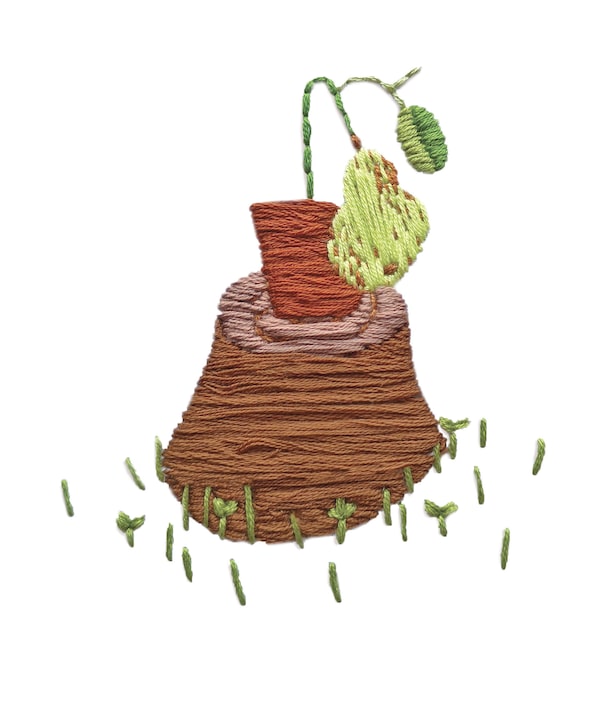
Illustration by Ashley Wong
First Person is a daily personal piece submitted by readers. Have a story to tell? See our guidelines at tgam.ca/essayguide.
When we first moved into our house 18 years ago, there was a pear tree right smack in the middle of the backyard. Its taller branches blocked an otherwise clear view of the rest of the yard and our neighbour’s yard, both of which were nicely landscaped. The tree was old, with spindly branches, and had a big, hollow gash in the middle large enough for a squirrel’s nest or several squirrel’s nests, as I eventually discovered. And were those carpenter ants I saw roaming around the trunk? I worried about what would happen if one of those almost-dead branches came down in a wind storm and maybe hit someone. I could imagine many scenarios, but the bottom line was: That tree looked like it was on its last legs or branches or roots or whatever the equivalent would be in tree anatomy. In its defence, it still had enough energy to produce a few flowers and even fewer fruit – they were Bosc pears and actually quite tasty. The tree’s fate hung in the balance for the first summer, while I weighed the pros and cons. But when my daughter, who loved climbing trees, got stung by a wasp in its branches, my tree vendetta began. I decided it had to come down. It was me or that tree.
Over the course of the next summer, bit by bit, I cut off old, dead branches, toiling for hours at a time to make bundles in 1.2-metre lengths so they would pass muster with the city’s garden waste pick-up crews. Who knew such a sickly specimen could generate so much wood? I started with my secateurs and clipped away at the lower, smaller branches. Then I pulled out the heavy artillery: Stepladder and hand saw, me perching precariously on the top step of the ladder. I continued to slave away, determined not to be outdone by the tree’s solid mass. Finally, after many weeks, I had a mostly branch-less tree – and an unsightly stump about two metres high. I suppose in some circles, the result might have been called art and its silhouette did look quite interesting against the evening sky at dusk. But, in all honesty, it wasn’t really a scenic improvement. I did, however, derive a certain satisfaction in having conquered a small piece of nature in my territory. After all, whose backyard was this anyway?
The tree skeleton remained just that for the rest of the summer. I admit it looked a little forlorn as winter set in and snow rested on its remains and the birds passed it over. But, no regrets.
The following summer, my neighbour kindly offered to cut the remaining trunk to the ground with his chain saw and I was delighted to have finally gained an unobstructed view right to the back of the yard. Only the stump remained. In the meantime, I had planted other, smaller trees, and now I could enjoy them as I sat on the patio. My neighbour even carried away several lengths of the trunk and branches to burn in his outdoor fire pit, which produces a lot of smoke and means I have to close the windows in my house. But at least the tree was no longer an eyesore. However, neither was it exactly gone. Every time I walked by the stump, it seemed to taunt me as it brazenly stood out from the greenness around it. I put a flower pot on top. That just seemed to draw more attention to it. I moved a wrought iron love seat from another location and tried that on top. Now it looked like I was trying to hide something.
A few weeks later, the guy who was laying a backyard path for me offered to dig into the remaining stump with his stone cutter. Wood chips went flying as he literally hacked away at the root. Images of chainsaw horror movies came to mind. When he was finished, the stump was now below ground and, he said, all I needed to do was shovel some soil and plant grass seed over the massacred little patch. I duly covered over where the tree used to stand, feeling smug about having conquered nature and thinking this was the end of the story.
Years went by, and I forgot about the pear tree. But then I started to notice a patch of grass that looked sickly, no matter how much grass seed I spread. The weeds, on the other hand, seemed to be thriving. I remembered the pear tree.
Fast forward a few more years and I’m still battling with the dying gasps of that tree. Grass will not grow over the little patch. I find pear-tree root seedlings growing everywhere in the backyard, including in the flower garden, several metres away from the original tree.
At some point, I will have to recognize that I did not conquer nature in my little patch of Toronto backyard, and that the pear tree is definitely getting the last laugh.
Woman: 0. Nature: 1.
Debra Scoffield lives in Toronto.